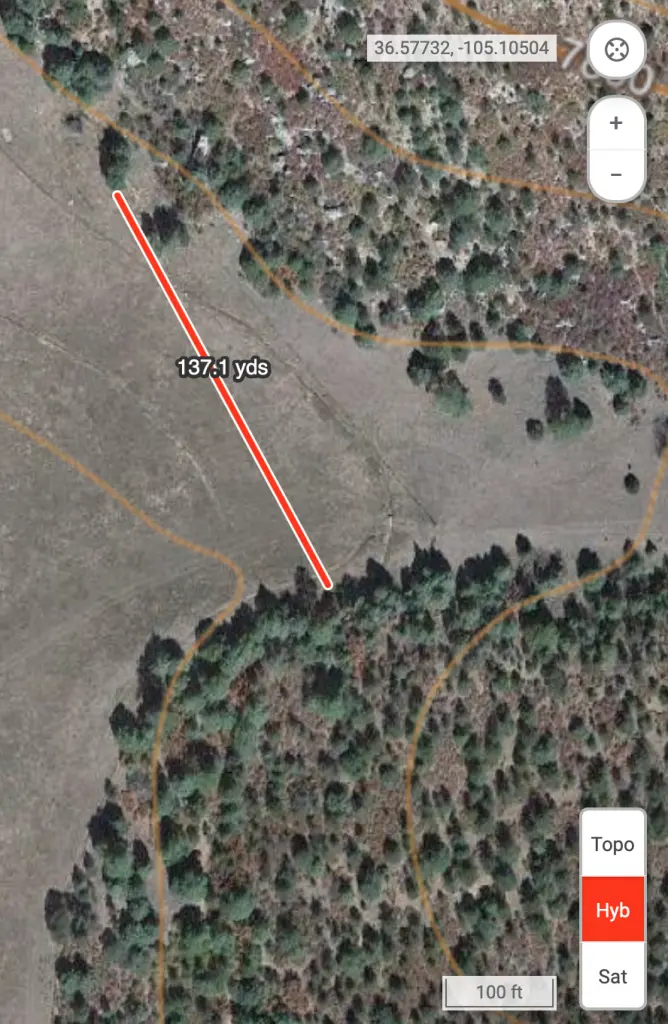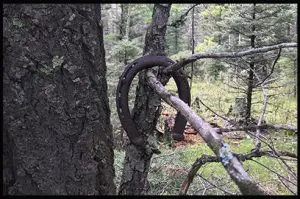
ElkBros Rule for Success:Identify your possible areas of failure and prepare to overcome them.
Hunting elk or deer in a fresh snow is an incredible experience. It’s like the whole world went silent and soft. The odd thing to me is even though the temperatures can be brutal and frigid, there is for me just something comforting about it. That is, if you are prepared for it.
I truly love hunting in the snow. But trust me when I say that it can be a hard, unforgiving and miserable experience with challenges that can compromise your hunt success or make tasks done in warmer weather unusually difficult, downright hard or even possibly dangerous. I have been there. I have made plenty of mistakes and discovered, often from my own suffering or missed opportunities, some common failure points.
Here are just a few for you to consider:
Rangefinder Failures
If you are hunting on a clear sunny day in the snow, this is not an issue. But if you are dealing with morning fog, falling snow or even a fine dry snow being picked up and blown around by the wind you will find that your rangefinder will give you false readings that are often recognizable as being wrong, but many times they are not.

For the rifle hunter, it can be incredibly hard to judge the distance of an elk and even harder for a deer in a fog or snowstorm. Difficult enough to make a shot questionable. For a bowhunter shooting pins and that has difficulty judging distance, a false reading becomes a deal breaker and the best shot is no shot.
So what are some ways to overcome this failure? For the bowhunter, there are two answers. The first would be to only take shots 30 yards or under. At that distance with today’s bows, you are in a good place. If the shot feels beyond your ability to judge at 30 or under, bail and count coup on the critter. There will be other opportunities and it’s a win for both you and the animal.
The second solution for the bowhunter is not that easy, but it raises your skill set and shooting confidence to a level that will help you all kinds in the long run. The second solution is to add unknown distance shots to your practice routine. There are many ways to do this, but two of my favorites are a game of horse with a partner, one guy shoots from a chosen distance and the partner then tries to match or beat. Whomever loses the round gets a letter…H..then O…then R and so on. Whomever spells ‘horse’ (or other names as decided on) first is the loser. And don’t let them forget it. This is one place where trash talking is TOTALLY allowed!
My second favorite way, especially if you shoot alone is what I call “walk-ups”. With 5 arrows and starting at your target, walk away on your target path and as you walk you throw an arrow out in front of you. Keep walking and throw another. Keep walking and another until all arrows are tossed at different distances. Then you go to the last arrow tossed and shoot that one at the target, judging the distance. Then you can either walk up to the next arrow OR you can skip the next one, shoot the third arrow tossed and then go to the fourth, then the 1st, then the second. Now, I need you to understand that Walk-ups happen after you have shot a lot of days, weeks, month of arrows at known ranges. It is not something that you just start with from day one. The known distance imprinting is important to being able to judge the unknown.
For the rifle hunter, I am going to give you a tip on something that I have done several times to make sure my hunter was within his effective and comfortable range or in the ballpark.

My backup tool is OnX. Most people know OnX as a mapping tool for identifying public and private boundaries, tracking your routes, adding waypoints or as a GPS to find your way back to your camp or another location. All great reasons for using OnX. But for the savy hunter, it is also a great way to get the distance from your current location, which is shown on the map, to a recognizable landmark, group of trees, fence line, hillside, etc. OnX has several map tools, but it is the Line Tool I am interested in. Using the Line Tool, you can start it right on your location and by looking at where your animal is located and finding a recognizable landmark nearby, you can then use the detailed maps to match that physical landmark or area to your animal’s location. Then simply place your second point of your line tool at that position and read the distance. No, it’s definitely not the exact yardage. But it is plenty close for a rifle hunter that knows his/her weapon and how it shoots.
Scope Failures
We spotted the herd of elk from about what seemed to be 500 yards out in a snow storm that was dropping enormously wet flakes. It was a perfect situation to get into position on a nice bull that had hung back next to the tree line in a small cul-de-sac off the main meadow somewhat off of the herd. The snow screened us and it was new and silent.
If we humped over and came out just to the south of the small park, we just might be able to get a shot before we lost too much more shooting light. As we topped the hill, we snuck down between some pines but still hadn’t spotted the bull. It was just then that I caught a movement through the snow, to our left. The bull was 200 yards out feeding towards the tree line and totally oblivious to the two of us setting up the shooting sticks.
With the bull only about 10 yards from the tree line, our opportunity was about to pass. Knowing the area I called out 200 yards as my hunter threw his gun up onto the shooting sticks and chambered a cartridge. It was right then that I heard some choice words from my hunter as he stopped, turned his gun up, stuck his finger into the front of his scope and started digging out snow that had filled up the front glass and totally blocked his vision.

In what seemed like an eternity, but only seconds, he looked through the scope and said he couldn’t see the bull. The image was totally distorted. In an attempt to clear and dry the glass on the front of the scope, he stood up and started pulling his shirt out from under his jacket and began to wipe the front glass. Again after what seemed an eternity and what must have looked like a comedy”, he again looked through the scope as I tried to again locate the bull. What had been a perfect opportunity was now nothing but the backend of the bull disappearing into the trees.
I have experienced different scope issues with many hunters over the years. Having the magnification too high in close situations. Not knowing how to locate an animal in a scope. Being unfamiliar with a new scope and having viewing issues. Dirt in the viewer, loose rings, fogging up, etc.
But for guys hunting in snowing conditions or after a good snow when branches are laden with falling powder or dumping on you when you bump them, uncovered scopes, especially when carried on a sling, are sure to get filled with snow as described in the scenario above.

There are a few options for rifle hunters to avoid this issue but a quick, easy, inexpensive solution is a simple neoprene scope cover. Quick and easy and they do a great job of keeping your scope free of snow or debris. I also suggest carrying some tissue for wiping out your scope should you get some moisture on your lenses.
Eye Glasses Failure

It’s hard to shoot something if you are unable to see it. In freezing temperatures, or especially with a frigid wind, a warm face mask becomes a lifesaver. But if you wear glasses while you hunt, it becomes a huge hassle when the warm breath that escapes around your nose and cheeks hits our cold glasses and constantly fogs them up. Especially if you just humped it up a hill to get in position for a shot, the whole situation becomes magnified with your hot breaths being exhaled harder and more frequent.

Sure, contact lenses are a quick solution, but for those of you that have never hunted in freezing temps and choose to wear glasses, this can catch you off guard and possibly at the worst time.
Here are a few solutions:
#1 – Using everyday dishwashing detergent, wipe some of the liquid on both sides of each lens and let it dry. Once dry, buff the glasses with a soft cloth so that they are clear. This is a type of anti-fog.
#2 – Anti-fog spray can be purchased from Amazon. Be sure to check reviews.

#3 – Specialized face masks made for snowmobilers don’t always look so great, but in freezing cold, who the heck cares! They are made to channel your warm breath away from escaping up your cheeks and nose which causes the problem.
4. Extending your glasses a little further away from your face can sometimes help allowing the glasses to cool faster and dissipate the warm air from your breath.
Avoid Miserable Gutting or Outdoor Processing
Just last week I had to gut, cape and then cut up a bull in 15 degree weather and because I didn’t understand the whole processing situation on this particular ranch, it quickly became miserable and even dangerous. When I heard we had a processing barn, I envisioned something waaaaayyyyy different than the open air pole barn that left us exposed to the wind and freezing temps. Needless to say, I was unprepared and it was not a good situation.
If you have ever had to gut an elk or deer in freezing temps, it’s really not that bad as your hands are in a warm body cavity. It’s once you are done that your bloody hands are going to freeze up.
Using thin latex gutting gloves during the warmer hunts are great because you can just peel them off and your hands are clean and dry and you’re good to go. They also work fine in freezing temps if you are only gutting and then removing the bloody gloves. However, if you are going to have your hands out and exposed to the freezing air for longer periods of time, they are not the gloves that you want to use.
The typical surgical latex gloves are so thin that water or blood on the outside of the glove feels like you are wearing no gloves at all. Your hands freeze and fingers can become numb. And when fingers become numb, things can get dangerous. In fact, during our miserable night deboning and quartering in 15 degree weather, one of our guides cut himself. Luckily it bled a lot, but it wasn’t an emergency situation….this time.
Suggested Solution:

I highly recommend for guys hunting in freezing temps to carry a pair of “flock lined” gutting gloves that are somewhat thicker than thin latex gloves. They are durable and can be cleaned and used over and over again. Thinly insulated or lined gloves are the way to go in freezing temps. You can find them in different compositions and different lengths. I prefer gloves that go past my elbows with some elastic to keep them in place. But each person is different. I also carry a couple of gallon ZipLoc bags so I can roll up and throw the gloves in them and clean them later.
Here are just a few links that you can use to find gloves you might prefer:
https://www.galeton.com/gloves/fully-coated-gloves/neoprene-coated-gloves/
If you haven’t done it before, hunting in the cold and snow is really something you should experience. If dressed and prepared, it is incredible. The animals are easier to spot against the white stuff. Reading and following tracks is something that takes you back to such a primal state. Back to our roots. Back to something special that stirs the soul. Dragging in snow is so much easier and you definitely don’t have to worry about the meat going bad in 4 hours.
Hunting in snow and cold definitely has advantages as well as difficulties. But as always… identify your possible failure points and prepare to overcome them.
Keep your broadheads sharp and your powder dry.



Late fall into winter is my favorite time to hunt! We’re challenged in many parts of Utah though as often the winter range is private. But you can still find the elk well into January in the forests on the margin. The quiet, not having to worry about getting too sweaty or cooling the meat, and the visibility of animals and tracks, and that other hunters rarely leave the roads, all make it a ton of fun!